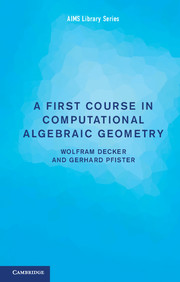Appel, K.; Haken, W.: The solution of the four-color map problem. Sci. Amer. 237, 108–121 (1977).
Aubry, Y.; Perret, M.: A Weil theorem for singular curves. In Arithmetic, Geometry and Coding Theory. Pellikaan, R., Perret, M. and Vladut, S. G. (eds), 1–7. Gruyter, De (1996).
Bandman, T.; Greuel, G.-M.; Grunewald, F.; Kunyavskii, B.; Pfister, G.; Plotkin, E.: Identities for finite solvable groups and equations in finite simple groups. Compositio Math. 142, 734–764 (2006).
Bierstone, E.; Milman, P.: Canonical desingularization in characteristic zero by blowing up the maximum strata of a local invariant. Invent. Math. 128, 207–302 (1997).
Birch, B.; Swinnerton-Dyer, H.: Notes on elliptic curves II. Journ. Reine u. Angewandte Math. 218, 79–108 (1965).
Bravo, A.; Encinas, S.; Villamayor, O.: A simplified proof of desingularisation and applications. Rev. Math. Iberoamericana 21, 349–458 (2005).
Buchberger, B.: Ein Algorithmus zum Auffinden der Basiselemente des Restklassenringes nach einem nulldimensionalen Polynomideal. PhD Thesis, University of Innsbruck, Austria (1965).
Cox, D.; Little, J.; O’Shea, D.: Ideals, Varieties and Algorithms, 3rd ed. Springer (2007).
Cox, D.; Little, J.; O’Shea, D.: Using Algebraic Geometry, 2nd ed. Springer (2005).
Decker, W.; Lossen, Chr.: Computing in Algebraic Geometry: A quick start using Singular. Springer (2006).
Decker, W.; Greuel, G.-M.; Pfister, P.: Primary decomposition: algorithms and comparisons. In Algorithmic Algebra and Number Theory, Gert-Martin, Greuel, Matzat, B. H., Hiss, G. (eds), 187–220. Springer (1998).
Decker, W.; Greuel, G.-M.; de Jong, T.; Pfister, G.: The normalization: a new algorithm, implementation and comparisons. In Computational Methods for Representations of Groups and Algebras, Dräxler, P., Michler, G., Ringel, C. M. (eds), 177–185. Birkhäauser (1999).
Decker, W.; Greuel, G.-M.; Pfister, G.; Schönemann, H.: Singular 3-1-5. A computer algebra system for polynomial computations. for Computer Algebra, University of Kaiserslautern, (2012).
Decker, W.; Schreyer, F. O.: Varieties, Gröbner Bases, and Algebraic Curves. To appear.
Dickenstein, A.; Emiris, I. Z. (editors): Solving Polynomial Equations: Foundations, Algorithms, and Applications. Algorithms and Computations in Mathematics 41, Springer (2005).
Doerk, K.; Hawkes, T.: Finite Soluble Groups. De Gruyter Expositions in Mathematics 4, Berlin (1992)
Eisenbud, D.; Grayson, D.; Stillman, M., Sturmfels, B.: Computations in Algebraic Geometry with Macaulay2. Springer (2001).
Faugère, J. C.; Gianni, P.; Lazard, D.; Mora, T.: Efficient computation of zero-dimensional Gröbner bases by change of ordering. Journal of Symbolic Computation 16, 329–344 (1993).
Feit, Walter; Thompson, John G.: Solvability of groups of odd order. Pacific Journal of Mathematics 13, 775–1029 (1963).
Frühbis-Krüger, A.; Pfister, G.: Algorithmic resolution of singularities. In Singularities and Computer Algebra, Lossen, C., Pfister, G. (eds). LMS Lecture Notes 324, 157–184. Cambridge University Press (2006).
Gianni, P.; Trager, B.; Zacharias, G.: Gröbner bases and primary decomposition of polynomial ideals. Journal of Symbolic Computation 6, 149–167 (1988).
Gordan, P.: Neuer Beweis des Hilbertschen Satzesüber homogene Funktionen. Nachrichten König. Ges. der Wiss. zu Gött., 240–242 (1899).
Grauert, H.: Über die Deformation isolierter Singularitäten analytischer Mengen. Invent. Math. 15, 171–198, (1972).
Greuel, G.-M.; Pfister, G.: Gröbner Bases and Algebraic Geometry. In Gröbner Bases and ApplicationsBuchberger, B. and Winkler, F. (eds). LMS Lecture Notes 251, 109–143. Cambridge University Press (1998).
Greuel, G.-M.; Pfister, G.: Computer algebra and finite groups. In Proc. of the ICM Beijing, 4–14 (2002).
Greuel, G.-M.; Pfister, G.: Singular and Applications. JJahresbericht der DMV 108 (4), 167–196 (2006).
Greuel, G.-M.; Pfister, G.: A Singular Introduction to Commutative Algebra. Second Edition. Springer (2007).
Gröbner, W.: Über die algebraischen Eigenschaften der Integrale von linearen Differentialgleichungen mit konstanten Koeffizienten. Monatsh. der Mathematik 47, 247–284, (1939).
Hilbert, D.: Über die Theorie der algebraischen Formen. Math. Ann. 36, 473–534 (1890).
Hironaka, H.: Resolution of singularities of an algebraic variety over a field of characteristic zero, Ann. Math. 79, 109–326 (1964).
Kemper, G.: Morphisms and constructible sets: Making two theorems of Chevalley constructive. Preprint (2007).
Kreuzer, M.; Robbiano, L.: Computational Commutative Algebra 1. Springer (2000).
Koblitz, N.: Elliptic curve cryptosystems. Mathematics of Computation 48, 203–209 (1987).
Labs, O.: A septic with 99 real nodes. Rend. Sem. Mat. Univ. Pad. 116, 299–313 (2006).
Lenstra, Jr., H. W.: Factoring integers with elliptic curves. Ann. Math. 2 (126), 649–673 (1987).
Macaulay, F. S.: Some properties of enumeration in the theory of modular systems. Proc. London Math. Soc. 26, 531–555, (1939).
Miller, V.: Use of elliptic curves in cryptography. In Advances in cryptology–-CRYPTO 85, Williams, Hugh C. (ed), Lecture Notes in Computer Science, 218, 417–426, Springer (1985).
Silvermann, Joseph H.: The Arithmetic of Elliptic Curves. Springer (2009).
Thompson, J.: Non-solvable finite groups all of whose local subgroups are solvable. Bull. Amer. Math. Soc. 74, 383–437 (1968).
Vasconcelos, W. V.: Computational Methods in Commutative Algebra and Algebraic Geometry. Springer (1998).
Wild, Marcel: The groups of order sixteen made easy. American Mathematical Monthly 112, (1) 20–31 (2005).
Wiles, A.: Modular elliptic curves and Fermat’s last theorem. Ann. Math 141, 443–551 (1995).
Zorn, M.: Nilpotency of finite groups. Bull. Amer. Math. Soc. 42, 485–486 (1936).

 Loading metrics...
Loading metrics...


